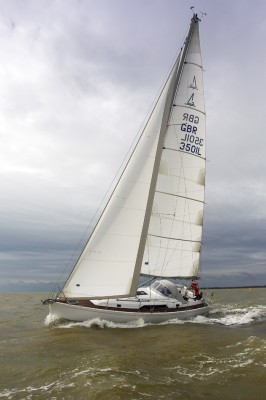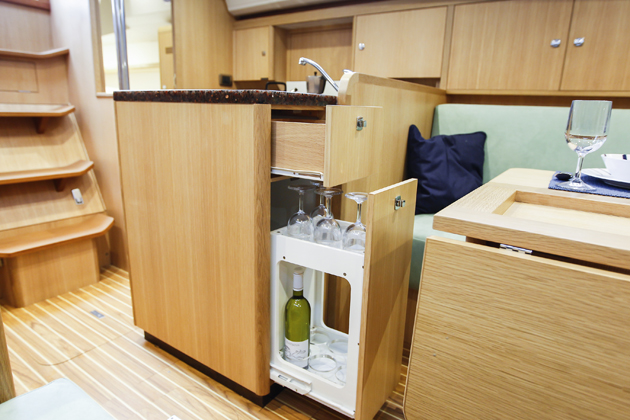Will quality, seaworthiness and strength for bluewater cruising make the GT35 a reliable mover? asks Pip Hare, who tested this boat in the blustery Solent
GT35 boat test – a British design for serious and safe ocean sailing
I tested the GT35 on a grey blustery day, the kind of day the average sailor avoids; only the stalwarts and passagemakers were out with us on the water. But then this boat was not designed for the average day sailor.
The principles of quality, seaworthiness and strength are core to the GT35. This British concept, design and build was created to stand up to serious and safe ocean sailing. That is not just what the brochure says, it is evident everywhere you look. My big question was whether such sensible shoes would weigh down a 35-footer. Does being safe mean no fun?
Heading straight out into a Force 7 on the Solent, the GT made its best effort to show me that you can dance in sensible shoes. Beating towards Cowes through a Solent chop, the boat felt alive; there was power enough for us to punch through waves. It was nimble and pleasant to helm, making an average speed of 6.3 knots upwind.
You can feel the weight of the GT, but this does not come back at you through the wheel; in the wind range I experienced the boat felt balanced and muscly, yet not cumbersome. From the back of the boat I felt cocooned and secure in the fully enclosed cockpit. With the sprayhood up, I had to sit out to feel the wind on my face and there was no chance of being peppered with spray as we bullied our way upwind.
Founder of GT Yachts Conrad Cockburn (a naval architect) has teamed up with designer Stephen Jones to address what he sees as a gap in the market for a quality 30-50ft, no-compromise cruiser. The end result is being built by Windboats – former builder of Oyster yachts – in Norfolk.
Hand-built British quality like this comes at a price and, at £240,500 ex VAT, the GT is restricted to a niche market. In the words of Stephen Jones: “The design requirement is not intended to be wholly revolutionary, but to provide a secure-feeling, steady range of yachts that are strong, fast and sensible.”
Having lived aboard a yacht myself for many years I was intrigued to see if their idea of steady cruising matched mine.
Comfort at sea
The GT looks modern, has reasonably high freeboard and visibly carries beam forward in the boat. However, on a second look the enclosed transom and high cockpit coamings give an indication this boat has been designed with comfort at sea in mind.
The deck is simple and clean, with lines – including the roller furler – leading back below deck and flush hatches. The coachroof leaves plenty of room to walk comfortably to the foredeck. A bosun’s locker forward is a feature rarely seen on a boat of this size, and is deep with ample room for ground tackle and fenders. It doubles as a floodable crash section, separated from the forward cabin by a watertight bulkhead. Another watertight bulkhead separates the rudder shaft from the aft cabin and large cockpit locker.

A neatly engineered bathing platform is made by dropping the transom down and removing part of the helmsman’s seat
The GT35 has a relatively high angle of vanishing stability (AVS) of 144° and STIX value of 54, which again point to its seaworthiness offshore. These are partly down to the increased amount of lead ballast placed low in the keel. To provide the strength to support this, key areas of the hull are reinforced with carbon fibre.
All the attention to detail, extra strength and stability, of course, come at a cost – and that’s weight. At 7.2 tonnes the GT is over a tonne heavier than some of its rivals. This is redressed with a larger sail plan.
As standard the GT35 comes with a mainsail and a furling genoa. Optional extras include provision for an inner forestay – an absolute must if heading offshore, in my opinion – and a self-tacking pack for a non-overlapping headsail.
Sail trials
I trialled the boat in gusty conditions, beating towards Cowes in winds ranging between 20 and 30 knots true. Upwind in over 24 knots the GT35 was more comfortable with a reef, which was easily put in thanks to sensibly placed winches, single-line slab-reefing (standard) and lazyjacks (optional). All this was done in comfort from behind the sprayhood. Likewise, tacking was easy and the sheets could comfortably be handled in the cockpit by one person.

A single large wheel allows steering from almost any position, but is a little cumbersome to get round
A full-width wheel allows steering from virtually any position, but is a little cumbersome to get around. Slide-away helm seats and well-placed foot wedges allow any number of sit-down, stand-up or leaning positions to windward or to leeward.
Comfort has also been considered for the often-forgotten crew. An entirely enclosed cockpit with high coamings gives security and ergonomic shape, offering decent back support while feet can brace on the seats opposite.
Though I appreciated the full width of the traveller I found it hard to adjust while under way; the loads on it were quite high and I found it difficult to recleat the rope while steering. Perhaps the cleats need to be angled up a little to make this action easier.
Off the wind we had every excuse to shake out the reefs and the boat made an easy 7 knots in a dying breeze of 18 knots. Both reaching and running the test boat made comfortable speed in moderate winds and, though pleasant, I found it unremarkable. But the GT35 was designed for steady, sensible cruising and in the conditions we experienced it met this brief.
For those who might like a bit more excitement off the breeze I felt the boat could easily handle more sail area. There are suitable points on the toerail where headsails could be led outboard for reaching and among the optional extras is a OneSails package, which could include an offshore main, furling Code 0 or a cruising chute. Personally I feel the versatility of the Code 0 would offer added upwind power in superlight airs and a lot of fun reaching.
The test boat had an upgraded 30hp engine with a varifold propeller and optional bow thruster. We motored fast with no effort against the incoming tide down the Hamble River. The boat was equally responsive manoeuvring in a blustery wind.
Below decks
I was impressed with the GT below. Some bold decisions have been made to provide a functional and comfortable boat, in particular the choice of sacrificing one aft cabin in favour of a sensibly placed, large heads and an enormous cockpit locker. The feeling of solidity and strength remained while the boat was crashing through Solent chop upwind; nothing creaked, and lockers/cabin doors opened and closed smoothly.
The attention to detail and consideration for living aboard and spending time at sea absolutely shone through. The oak finish with solid grabrails provides a contemporary feel and there are handholds aplenty and over 6ft of headroom throughout.
The saloon is forward of the galley and has a permanent table in the centre with settee berths on both sides and stowage outboard. There is undoubtedly a compromise on space with this set-up, however anyone who has run the gauntlet trying to get across an empty saloon at sea and ended up hanging off a grabrail may feel the compromise is justified.
Bringing the forward cabin a little bit further aft in the boat has given the master cabin dimensions for a decent-sized berth, with room to stand. Stowage is in hanging lockers and below the berth.
The galley is large with plenty of worktop. Inboard of the sink this extends to the centreline, providing a well-placed anchor for crew coming down the companionway. At the bottom of the companionway you are straight into a neat triangle of heads, galley and navigation area; so there is no need for wet crew to trail through the boat.
The heads has plenty of room to stand up, shower or take off foulweather gear. Behind the fore and aft-mounted toilet is a wet-locker, which has an outlet from the engine room blower. I jammed myself into the forward-facing navstation while sailing upwind and was able to brace myself on both tacks with ample room to work.
Knowing the pain of squeezing my body into unnatural shapes with a torch in my mouth and only one hand free to work with, I was pleased to see that access to wiring, plumbing, engine and steering has been given as much consideration as the rest of the boat. The electrical wiring throughout is run through dedicated conduits, which are not jampacked full. There is even a chain running through the limber holes in the structural beams under the floorboards to keep them free of boat fluff.
Maintenance access for the engine is via the companionway and knuckle room has been allowed. All through-hull fittings are easily accessed and toilet plumbing also.
Specifications
LOA 10.70m/35ft 0in
LWL 10.00m/32ft 10in
Beam (max) 3.60m/11ft 10in
Draught 1.95m/6ft 5in
Disp (lightship) 7,500kg/16,535lb
Ballast 2,810kg/6,195lb
Sail area (100% foretriangle) 67m2/722ft2
Berths 6
Engine 25hp
Water 230lt/51gal
Fuel 230lt/51gal
Sail area:disp 18
Disp:LWL 210
Price (ex VAT) £240,500
Designed by Stephen Jones
Conclusion
GT stands for Grand Tour and this boat has definitely been designed with that concept in mind. I was hugely impressed with the level of understanding and attention to detail that has gone into making this boat fit its design brief. It will appeal to any sailor who knows the pain of cruising on a boat designed for the harbour.
But at around £300,000 on the water this is an expensive boat, more so in fact in comparative terms than established quality brands with high resale values, including the Xc35 and even the HR372.
In a survey recently conducted on the motivations of yachtsmen, ‘freedom’ came out as the top reason why we sail. For me freedom is endless sky and ocean, no boundaries and feeling the elements on my skin. The GT35 did not make me feel that way. I felt secure and protected and perhaps a little mollycoddled. I understand and appreciate the GT for what it is, but it is not the boat for me.
Of course, a quick blast up and down the Solent is not a just reflection of the GT35’s capabilities. I’m sure the consideration to layout and ease of sailing would really come to life when cooking dinner during a wet night-time beat, or watching the sunrise from a dry cockpit on a rough crossing – perhaps even I wouldn’t be so keen to connect with the elements then.
This is an extract from a feature in Yachting World March 2015 issue










